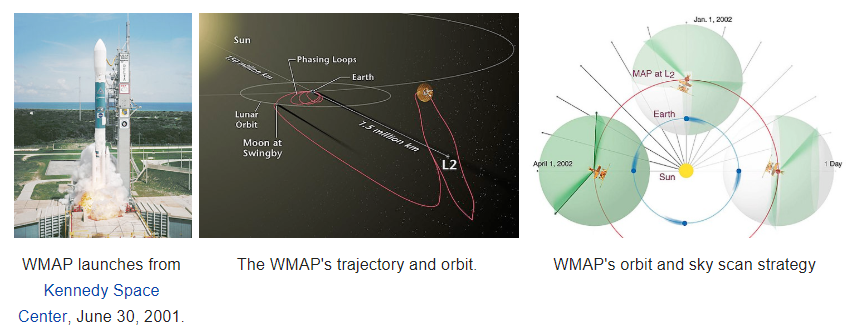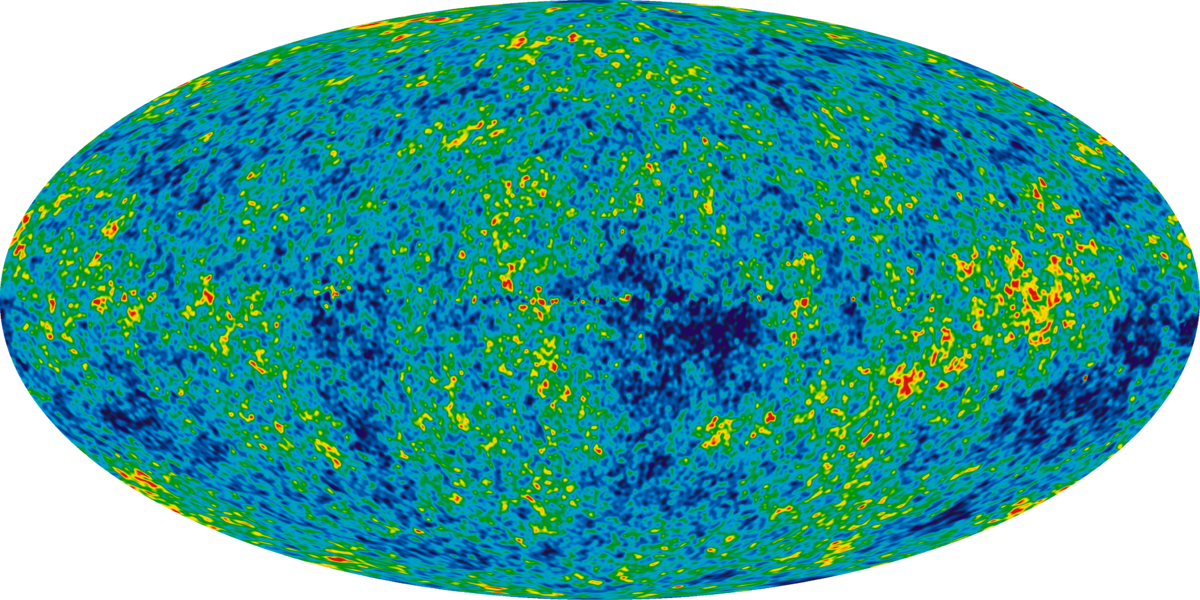WMAP Satellite
The Wilkinson Microwave Anisotropy Probe (WMAP), originally known as the Microwave Anisotropy Probe (MAP), was a spacecraft operating from 2001 to 2010 which measured temperature differences across the sky in the cosmic microwave background (CMB) – the radiant heat remaining from the Big Bang. Headed by Professor Charles L. Bennett of Johns Hopkins University, the mission was developed in a joint partnership between the NASA Goddard Space Flight Center and Princeton University. The WMAP spacecraft was launched on June 30, 2001 from Florida. The WMAP mission succeeded the COBE space mission and was the second medium-class (MIDEX) spacecraft in the NASA Explorers program. In 2003, MAP was renamed WMAP in honor of cosmologist David Todd Wilkinson (1935–2002), who had been a member of the mission's science team. After nine years of operations, WMAP was switched off in 2010, following the launch of the more advanced Planck spacecraft by ESA in 2009.
WMAP's measurements played a key role in establishing the current Standard Model of Cosmology: the Lambda-CDM model. The WMAP data are very well fit by a universe that is dominated by dark energy in the form of a cosmological constant. Other cosmological data are also consistent, and together tightly constrain the Model. In the Lambda-CDM model of the universe, the age of the universe is 13.772±0.059 billion years. The WMAP mission's determination of the age of the universe is to better than 1% precision.

The WMAP objective was to measure the temperature differences in the Cosmic Microwave Background (CMB) radiation. The anisotropies then were used to measure the universe's geometry, content, and evolution; and to test the Big Bang model, and the cosmic inflation theory. For that, the mission created a full-sky map of the CMB, with a 13 arcminute resolution via multi-frequency observation. The map required the fewest systematic errors, no correlated pixel noise, and accurate calibration, to ensure angular-scale accuracy greater than its resolution. The map contains 3,145,728 pixels, and uses the HEALPix scheme to pixelize the sphere. The telescope also measured the CMB's E-mode polarization, and foreground polarization. Its service life was 27 months; 3 to reach the L2 position, 2 years of observation.

The MAP mission was proposed to NASA in 1995, selected for definition study in 1996, and approved for development in 1997.
The WMAP was preceded by two missions to observe the CMB; (i) the Soviet RELIKT-1 that reported the upper-limit measurements of CMB anisotropies, and (ii) the U.S. COBE satellite that first reported large-scale CMB fluctuations. The WMAP was 45 times more sensitive, with 33 times the angular resolution of its COBE satellite predecessor. The successor European Planck mission (operational 2009–2013) had a higher resolution and higher sensitivity than WMAP and observed in 9 frequency bands rather than WMAP's 5, allowing improved astrophysical foreground models.

The telescope's primary reflecting mirrors are a pair of Gregorian 1.4m × 1.6m dishes (facing opposite directions), that focus the signal onto a pair of 0.9m × 1.0m secondary reflecting mirrors. They are shaped for optimal performance: a carbon fibre shell upon a Korex core, thinly-coated with aluminium and silicon oxide. The secondary reflectors transmit the signals to the corrugated feedhorns that sit on a focal plane array box beneath the primary reflectors.
The receivers are polarization-sensitive differential radiometers measuring the difference between two telescope beams. The signal is amplified with HEMT low-noise amplifiers, built by the National Radio Astronomy Observatory. There are 20 feeds, 10 in each direction, from which a radiometer collects a signal; the measure is the difference in the sky signal from opposite directions. The directional separation azimuth is 180 degrees; the total angle is 141 degrees. To improve subtraction of foreground signals from our Milky Way galaxy, the WMAP used five discrete radio frequency bands, from 23 GHz to 94 GHz.

The WMAP's base is a 5.0m-diameter solar panel array that keeps the instruments in shadow during CMB observations, (by keeping the craft constantly angled at 22 degrees, relative to the Sun). Upon the array sit a bottom deck (supporting the warm components) and a top deck. The telescope's cold components: the focal-plane array and the mirrors, are separated from the warm components with a cylindrical, 33 cm-long thermal isolation shell atop the deck.
Passive thermal radiators cool the WMAP to ca. 90 degrees K; they are connected to the low-noise amplifiers. The telescope consumes 419 W of power. The available telescope heaters are emergency-survival heaters, and there is a transmitter heater, used to warm them when off. The WMAP spacecraft's temperature is monitored with platinum resistance thermometers.
The WMAP's calibration is effected with the CMB dipole and measurements of Jupiter; the beam patterns are measured against Jupiter. The telescope's data are relayed daily via a 2 GHz transponder providing a 667 kbit/s downlink to a 70m Deep Space Network telescope. The spacecraft has two transponders, one a redundant back-up; they are minimally active – ca. 40 minutes daily – to minimize radio frequency interference. The telescope's position is maintained, in its three axes, with three reaction wheels, gyroscopes, two star trackers and sun sensors, and is steered with eight hydrazine thrusters.

Main result
WMAP's Top Ten
The WMAP science team has…
- ... has put the "precision" in "precision cosmology" by reducing the allowed volume of cosmological parameters by a factor in excess of 68,000. The three most highly cited physics and astronomy papers published in the new millennium are WMAP scientific papers--- reflecting WMAP's enormous impact.
- …mapped the pattern of tiny fluctuations in the Cosmic Microwave Background (CMB) radiation (the oldest light in the universe) and produced the first fine-resolution (0.2 degree) full-sky map of the microwave sky.
- …determined the universe to be 13.77 billion years old to within a half percent.
- …nailed down the curvature of space to within 0.4% of "flat" Euclidean.
- …determined that ordinary atoms (also called baryons) make up only 4.6% of the universe
- …completed a census of the universe and finds that dark matter (matter not made up of atoms) is 24.0%
- …determined that dark energy, in the form of a cosmological constant, makes up 71.4% of the universe, causing the expansion rate of the universe to speed up. - Lingering doubts about the existence of dark energy and the composition of the universe dissolved when the WMAP satellite took the most detailed picture ever of the cosmic microwave background (CMB).
- … mapped the polarization of the microwave radiation over the full sky and discovered that the universe was reionized earlier than previously believed. - WMAP scores on large-scale structure. By measuring the polarization in the CMB it is possible to look at the amplitude of the fluctuations of density in the universe that produced the first galaxies. That is a real breakthrough in our understanding of the origin of structure.
- …detected that the amplitude of the variations in the density of the universe on big scales is slightly larger than smaller scales. This, along with other results, supports "inflation", the idea is that the universe underwent a dramatic period of expansion, growing by more than a trillion trillion fold in less than a trillionth of a trillionth of a second. Tiny fluctuations were generated during this expansion that eventually grew to form galaxies.
- … determined that the distribution of these fluctuations follows a bell curve with the same properties across the sky, and that there are equal numbers of hot and cold spots in the map. The simplest version of the inflation idea predicted these properties and remarkably, WMAP’s precision measurement of the properties of the fluctuations has confirmed these predictions, in detail.

The main result of the mission is contained in the various oval maps of the CMB temperature differences. These oval images present the temperature distribution derived by the WMAP team from the observations by the telescope during the mission. Measured is the temperature obtained from a Planck's law interpretation of the microwave background. The oval map covers the whole sky. The results are a snapshot of the universe around 375,000 years after the Big Bang, which happened about 13.8 billion years ago. The microwave background is very homogeneous in temperature (the relative variations from the mean, which presently is still 2.7 kelvins, are only of the order of 5×10−5). The temperature variations corresponding to the local directions are presented through different colors (the "red" directions are hotter, the "blue" directions cooler than the average).







REFERENCES
Nasa. Available in: https://map.gsfc.nasa.gov/. Access in: 13/12/2018.
Nasa. Available in: https://wmap.gsfc.nasa.gov/news/. Access in: 13/12/2018.
Nasa. Available in: https://www.nasa.gov/topics/universe/features/wmap-complete.html. Access in: 13/12/2018.
Wikipedia. Available in: https://en.wikipedia.org/wiki/Wilkinson_Microwave_Anisotropy_Probe. Access in: 13/12/2018.
Science Daily. Available in: https://www.sciencedaily.com/releases/2010/06/100613212708.htm. Access in: 13/12/2018.















0 comments
Sign in or create a free account